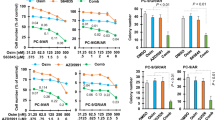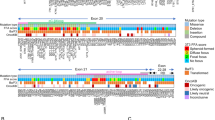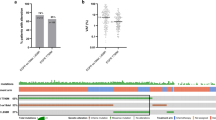Abstract
The third-generation mutation-selective EGFR tyrosine kinase inhibitor (EGFR-TKI) osimertinib (or AZD9291) effectively induces apoptosis in EGFR mutant (EGFRm) non-small cell lung cancer (NCSLC) cells. However, the underlying mechanisms have not been fully elucidated. Tumor necrosis factor-related apoptosis-inducing ligand (TRAIL or TNFSF10) is known as a death ligand that initiates apoptosis via binding to its cell surface death receptors such as DR5. In this study, we found that osimertinib and other EGFR-TKIs increased the expression of TRAIL primarily in EGFRm NSCLC cell lines. This effect was accompanied with increased IL6 expression and STAT3 activation. Inhibition of STAT3 with either protein degradation or gene knockout abrogated the ability of osimertinib or recombinant human IL6 to elevate TRAIL levels. Moreover, osimertinib increased STAT3-dependent transcription of TRAIL via two STAT3 novel binding sites present in the TRAIL 5’flanking region. Hence, osimertinib induces IL6/STAT3-mediated TRAIL expression in EGFRm NSCLC cells. While osimertinib lost the ability to induce TRAIL expression in osimertinib-resistant EGFRm NSCLC, knockdown or knockout of TRAIL in sensitive EGFRm NSCLC cells rendered them less sensitive to osimertinib both in vitro and in vivo. Thus, TRAIL elevation contributes to the induction of apoptosis by osimertinib in EGFRm NSCLC cells. Furthermore, osimertinib increased membrane-bound TRAIL and DR5 membrane clustering and DR5 knockdown significantly compromised the cell-killing effect of osimertinib, together suggesting a DR5-dependent effect. Collectively, this study has revealed a previously undiscovered connection between TRAIL induction and osimertinib-induced apoptosis in EGFRm NSCLC cells, increasing our understanding of mechanisms accounting for apoptosis induced by osimertinib.
This is a preview of subscription content, access via your institution
Access options
Subscribe to this journal
Receive 50 print issues and online access
269,00 € per year
only 5,38 € per issue
Buy this article
- Purchase on SpringerLink
- Instant access to full article PDF
Prices may be subject to local taxes which are calculated during checkout







Similar content being viewed by others
Data availability
All data generated in this study are presented in the article.
References
Tartarone A, Lerose R. Clinical approaches to treat patients with non-small cell lung cancer and epidermal growth factor receptor tyrosine kinase inhibitor acquired resistance. Ther Adv Respir Dis. 2015;9:242–50.
Nagasaka M, Zhu VW, Lim SM, Greco M, Wu F, Ou SI. Beyond osimertinib: the development of third-generation egfr tyrosine kinase inhibitors for advanced EGFR+ NSCLC. J Thorac Oncol. 2021;16:740–63.
Ramalingam SS, Vansteenkiste J, Planchard D, Cho BC, Gray JE, Ohe Y, et al. Overall Survival with Osimertinib in Untreated, EGFR-Mutated Advanced NSCLC. N Engl J Med. 2020;382:41–50.
Blaquier JB, Ortiz-Cuaran S, Ricciuti B, Mezquita L, Cardona AF, Recondo G. Tackling osimertinib resistance in EGFR mutant non-small cell lung cancer. Clin Cancer Res. 2023;29:3579–91.
Zalaquett Z, Catherine Rita Hachem M, Kassis Y, Hachem S, Eid R, Raphael Kourie H, et al. Acquired resistance mechanisms to osimertinib: the constant battle. Cancer Treat Rev. 2023;116:102557.
Gomatou G, Syrigos N, Kotteas E. Osimertinib resistance: molecular mechanisms and emerging treatment options. Cancers. 2023;15:841.
Tang ZH, Lu JJ. Osimertinib resistance in non-small cell lung cancer: mechanisms and therapeutic strategies. Cancer Lett. 2018;420:242–6.
Hengartner MO. The biochemistry of apoptosis. Nature. 2000;407:770–6.
Fesik SW. Promoting apoptosis as a strategy for cancer drug discovery. Nat Rev Cancer. 2005;5:876–85.
Shi P, Oh YT, Deng L, Zhang G, Qian G, Zhang S, et al. Overcoming acquired resistance to AZD9291, a third-generation EGFR inhibitor, through modulation of MEK/ERK-dependent Bim and Mcl-1 degradation. Clin Cancer Res. 2017;23:6567–79.
Shi P, Zhang S, Zhu L, Qian G, Ren H, Ramalingam SS, et al. The third-generation EGFR inhibitor, osimertinib, promotes c-FLIP degradation, enhancing apoptosis including TRAIL-induced apoptosis in NSCLC cells with activating EGFR mutations. Transl Oncol. 2019;12:705–13.
Wiley SR, Schooley K, Smolak PJ, Din WS, Huang CP, Nicholl JK, et al. Identification and characterization of a new member of the TNF family that induces apoptosis. Immunity. 1995;3:673–82.
Montinaro A, Walczak H. Harnessing TRAIL-induced cell death for cancer therapy: a long walk with thrilling discoveries. Cell Death Differ. 2023;30:237–49.
Pimentel JM, Zhou JY, Wu GS. The role of TRAIL in apoptosis and immunosurveillance in cancer. Cancers. 2023;15:2752.
Smyth MJ, Takeda K, Hayakawa Y, Peschon JJ, van den Brink MR, Yagita H. Nature’s TRAIL-on a path to cancer immunotherapy. Immunity. 2003;18:1–6.
Falschlehner C, Schaefer U, Walczak H. Following TRAIL’s path in the immune system. Immunology. 2009;127:145–54.
Liu S, Polsdofer EV, Zhou L, Ruan S, Lyu H, Hou D, et al. Upregulation of endogenous TRAIL-elicited apoptosis is essential for metformin-mediated antitumor activity against TNBC and NSCLC. Mol Ther Oncolytics. 2021;21:303–14.
Allen JE, Krigsfeld G, Mayes PA, Patel L, Dicker DT, Patel AS, et al. Dual inactivation of Akt and ERK by TIC10 signals Foxo3a nuclear translocation, TRAIL gene induction, and potent antitumor effects. Sci Transl Med. 2013;5:171ra117.
Lund P, Kotova I, Kedinger V, Khanwalkar H, Voltz E, Hahn WC, et al. Transformation-dependent silencing of tumor-selective apoptosis-inducing TRAIL by DNA hypermethylation is antagonized by decitabine. Mol Cancer Ther.2011;10:1611–23.
Cho SD, Yoon K, Chintharlapalli S, Abdelrahim M, Lei P, Hamilton S, et al. Nur77 agonists induce proapoptotic genes and responses in colon cancer cells through nuclear receptor-dependent and nuclear receptor-independent pathways. Cancer Res. 2007;67:674–83.
Oh YT, Yue P, Zhou W, Balko JM, Black EP, Owonikoko TK, et al. Oncogenic Ras and B-Raf proteins positively regulate death receptor 5 expression through co-activation of ERK and JNK signaling. J Biol Chem. 2012;287:257–67.
Oh YT, Liu X, Yue P, Kang S, Chen J, Taunton J, et al. ERK/ribosomal S6 kinase (RSK) signaling positively regulates death receptor 5 expression through co-activation of CHOP and Elk1. J Biol Chem. 2010;285:41310–9.
Shi P, Oh YT, Zhang G, Yao W, Yue P, Li Y, et al. Met gene amplification and protein hyperactivation is a mechanism of resistance to both first and third-generation EGFR inhibitors in lung cancer treatment. Cancer Lett. 2016;380:494–504.
Xu J, Zhou JY, Wu GS. Tumor necrosis factor-related apoptosis-inducing ligand is required for tumor necrosis factor alpha-mediated sensitization of human breast cancer cells to chemotherapy. Cancer Res. 2006;66:10092–9.
Maadi H, Nami B, Wang Z. Dimerization assessment of epithelial growth factor family of receptor tyrosine kinases by using cross-linking reagent. Methods Mol Biol. 2017;1652:101–8.
Turk HF, Chapkin RS. Analysis of epidermal growth factor receptor dimerization by BS(3) cross-linking. Methods Mol Biol. 2015;1233:25–34.
Zhang S, Qian G, Shi P, Zhang G, Fan S, He Y, et al. Downregulation of death receptor 4 is tightly associated with positive response of EGFR mutant lung cancer to EGFR-targeted therapy and improved prognosis. Theranostics. 2021;11:3964–80.
Zhu L, Chen Z, Zang H, Fan S, Gu J, Zhang G, et al. Targeting c-Myc to overcome acquired resistance of EGFR mutant NSCLC cells to the third-generation EGFR tyrosine kinase inhibitor, osimertinib. Cancer Res. 2021;81:4822–34.
Brown K, Comisar C, Witjes H, Maringwa J, de Greef R, Vishwanathan K, et al. Population pharmacokinetics and exposure-response of osimertinib in patients with non-small cell lung cancer. Br J Clin Pharm. 2017;83:1216–26.
Matsuda T. The physiological and pathophysiological role of IL-6/STAT3-mediated signal transduction and STAT3 binding partners in therapeutic applications. Biol Pharm Bull. 2023;46:364–78.
Bai L, Zhou H, Xu R, Zhao Y, Chinnaswamy K, McEachern D, et al. A potent and selective small-molecule degrader of STAT3 achieves complete tumor regression in vivo. Cancer Cell. 2019;36:498–511.e417.
Zhou H, Bai L, Xu R, Zhao Y, Chen J, McEachern D, et al. Structure-based discovery of SD-36 as a potent, selective, and efficacious PROTAC degrader of STAT3 protein. J Med Chem. 2019;62:11280–300.
Wang J, Wang Y, Zheng C, Hou K, Zhang T, Qu X, et al. Tyrosine kinase inhibitor-induced IL-6/STAT3 activation decreases sensitivity of EGFR-mutant non-small cell lung cancer to icotinib. Cell Biol Int. 2018;42:1292–9.
Ishiguro Y, Ishiguro H, Miyamoto H. Epidermal growth factor receptor tyrosine kinase inhibition up-regulates interleukin-6 in cancer cells and induces subsequent development of interstitial pneumonia. Oncotarget. 2013;4:550–9.
Li L, Li Z, Lu C, Li J, Zhang K, Lin C, et al. Ibrutinib reverses IL-6-induced osimertinib resistance through inhibition of Laminin alpha5/FAK signaling. Commun Biol. 2022;5:155.
Vallania F, Schiavone D, Dewilde S, Pupo E, Garbay S, Calogero R, et al. Genome-wide discovery of functional transcription factor binding sites by comparative genomics: the case of Stat3. Proc Natl Acad Sci USA. 2009;106:5117–22.
Seidel HM, Milocco LH, Lamb P, Darnell JE Jr, Stein RB, Rosen J. Spacing of palindromic half sites as a determinant of selective STAT (signal transducers and activators of transcription) DNA binding and transcriptional activity. Proc Natl Acad Sci USA. 1995;92:3041–5.
Ihle JN. STATs: signal transducers and activators of transcription. Cell. 1996;84:331–4.
von Karstedt S, Montinaro A, Walczak H. Exploring the TRAILs less travelled: TRAIL in cancer biology and therapy. Nat Rev Cancer. 2017;17:352–66.
Pan L, Fu TM, Zhao W, Zhao L, Chen W, Qiu C, et al. Higher-order clustering of the transmembrane anchor of DR5 drives signaling. Cell. 2019;176:1477–89.e1414.
Du G, Zhao L, Zheng Y, Belfetmi A, Cai T, Xu B, et al. Autoinhibitory structure of preligand association state implicates a new strategy to attain effective DR5 receptor activation. Cell Res. 2023;33:131–46.
Lee HK, Noh MH, Hong SW, Kim SM, Kim SH, Kim YS, et al. Erlotinib activates different cell death pathways in EGFR-mutant lung cancer cells grown in 3D versus 2D culture systems. Anticancer Res. 2021;41:1261–9.
Chen S, Fu L, Raja SM, Yue P, Khuri FR, Sun SY. Dissecting the roles of DR4, DR5 and c-FLIP in the regulation of geranylgeranyltransferase I inhibition-mediated augmentation of TRAIL-induced apoptosis. Mol Cancer. 2010;9:23.
Naval J, de Miguel D, Gallego-Lleyda A, Anel A, Martinez-Lostao L. Importance of TRAIL Molecular anatomy in receptor oligomerization and signaling. Implications for cancer therapy. Cancers. 2019;11:444.
Chang Q, Bournazou E, Sansone P, Berishaj M, Gao SP, Daly L, et al. The IL-6/JAK/Stat3 feed-forward loop drives tumorigenesis and metastasis. Neoplasia. 2013;15:848–62.
Acknowledgements
We are thankful to Dr. Gen-Sheng Wu for providing reporter constructs with TRAIL 5’-flanking region used in this study. We are grateful to Dr. Anthea Hammond in our department for editing the manuscript. This work was supported by NIH/NCI R01 CA223220 (to SYS) and UG1 CA233259 (to SSR/SY) and by the David A. Cole Family Professorship. SSR and SYS are Georgia Research Alliance Distinguished Cancer Research Scholars. SYS is a David A. Cole Family Professor.
Author information
Authors and Affiliations
Contributions
Conceptualization: Y-TO, and S-YS. Investigation: Y-TO, ZC, and DW. Methodology: Y-TO, ZC, and DW. Writing/Original Draft: Y-TO, and S-YS. Review/Editing: ZC, DW, and SSR. Funding Acquisition: SSR, and S-YS. Supervision: S-Y.S.
Corresponding author
Ethics declarations
Competing interests
SSR is on consulting/advisory board for AstraZeneca, BMS, Merck, Roche, Tesaro and Amgen. Other authors disclose that they have no potential conflicts of interest.
Ethics approval and consent to participate
Animal experiment was approved by the Institutional Animal Care and Use Committee (IACUC) of Emory University (PROTO201700718). All methods were performed in accordance with the relevant guidelines and regulations.
Additional information
Publisher’s note Springer Nature remains neutral with regard to jurisdictional claims in published maps and institutional affiliations.
Rights and permissions
Springer Nature or its licensor (e.g. a society or other partner) holds exclusive rights to this article under a publishing agreement with the author(s) or other rightsholder(s); author self-archiving of the accepted manuscript version of this article is solely governed by the terms of such publishing agreement and applicable law.
About this article
Cite this article
Oh, YT., Chen, Z., Wang, D. et al. Induction of IL6/STAT3-dependent TRAIL expression that contributes to the therapeutic efficacy of osimertinib in EGFR mutant NSCLC cells. Oncogene 44, 2315–2327 (2025). https://doi.org/10.1038/s41388-025-03381-5
Received:
Revised:
Accepted:
Published:
Issue Date:
DOI: https://doi.org/10.1038/s41388-025-03381-5



